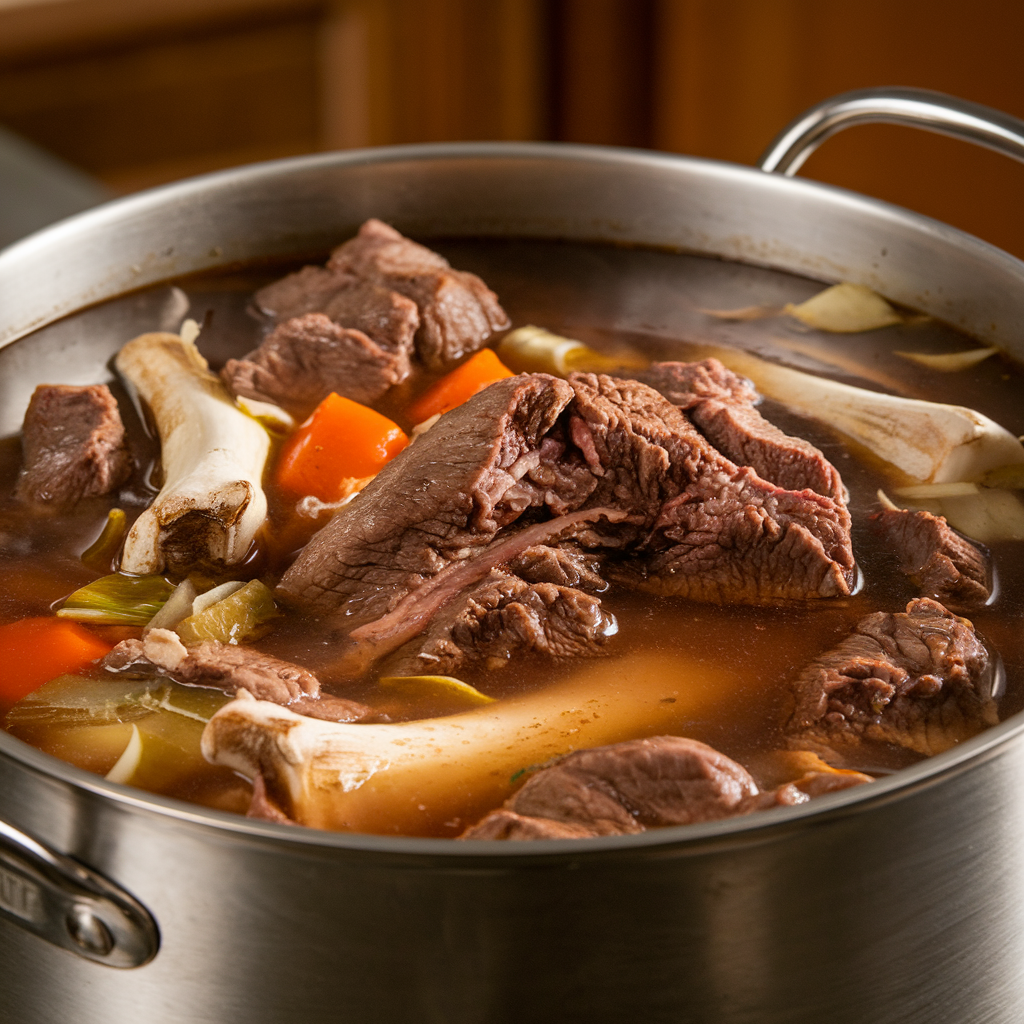Introduction
Soup bones are an essential ingredient in many culinary traditions, used to create rich, hearty broths and add depth of flavor to a variety of dishes. They are the foundation of countless soups, stews, gravies, and sauces, providing both taste and nourishment. Whether you’re making a classic beef broth or experimenting with lamb soup, soup bones offer a simple yet powerful way to elevate your cooking. This article will explore what soup bones are, the different types of bones used in cooking, how to make the best broth, and more.
Soup bones have been a staple in kitchens for centuries, particularly in cultures that emphasize using every part of the animal in cooking. They were traditionally considered a humble, economical way to extract maximum flavor and nutrition from less expensive cuts of meat. Today, they remain popular not only for their flavor-enhancing properties but also for their numerous health benefits. Packed with collagen, amino acids, and minerals, they provide essential nutrients for joint health, gut health, and even skin elasticity.
In this article, we’ll dive deep into the world of soup bones, providing tips on how to choose the right ones, the best ways to cook them, and how to maximize their use in various recipes.
Types of Soup Bones
When it comes to choosing the best soup bones for your recipe, the type of bone used will directly affect the flavor and richness of your broth. Different animals produce distinct flavors, and each bone type offers unique advantages. Here, we’ll break down the most common types of soup bones, how they’re used, and what makes them special.
Beef Soup Bones
Beef soup bones are among the most popular and widely used bones in cooking. Typically, they include marrow bones, knuckle bones, and oxtails, all of which contribute to a hearty, flavorful broth.
- Marrow Bones: Marrow bones come from the legs of the cow and are often used in recipes where a rich, creamy texture is desired. The marrow inside these bones is packed with fat and flavor, which helps to create a velvety-smooth broth.
- Oxtail: This cut comes from the tail of the cow and is known for its tender, gelatinous meat and rich marrow. Oxtail soup is a delicacy in many cuisines, offering a meaty and deeply flavorful broth.
- Knuckle Bones: These bones, found in the joints of the cow, are often used to create a gelatin-rich broth due to their high collagen content. They break down during cooking, adding thickness and body to the broth.
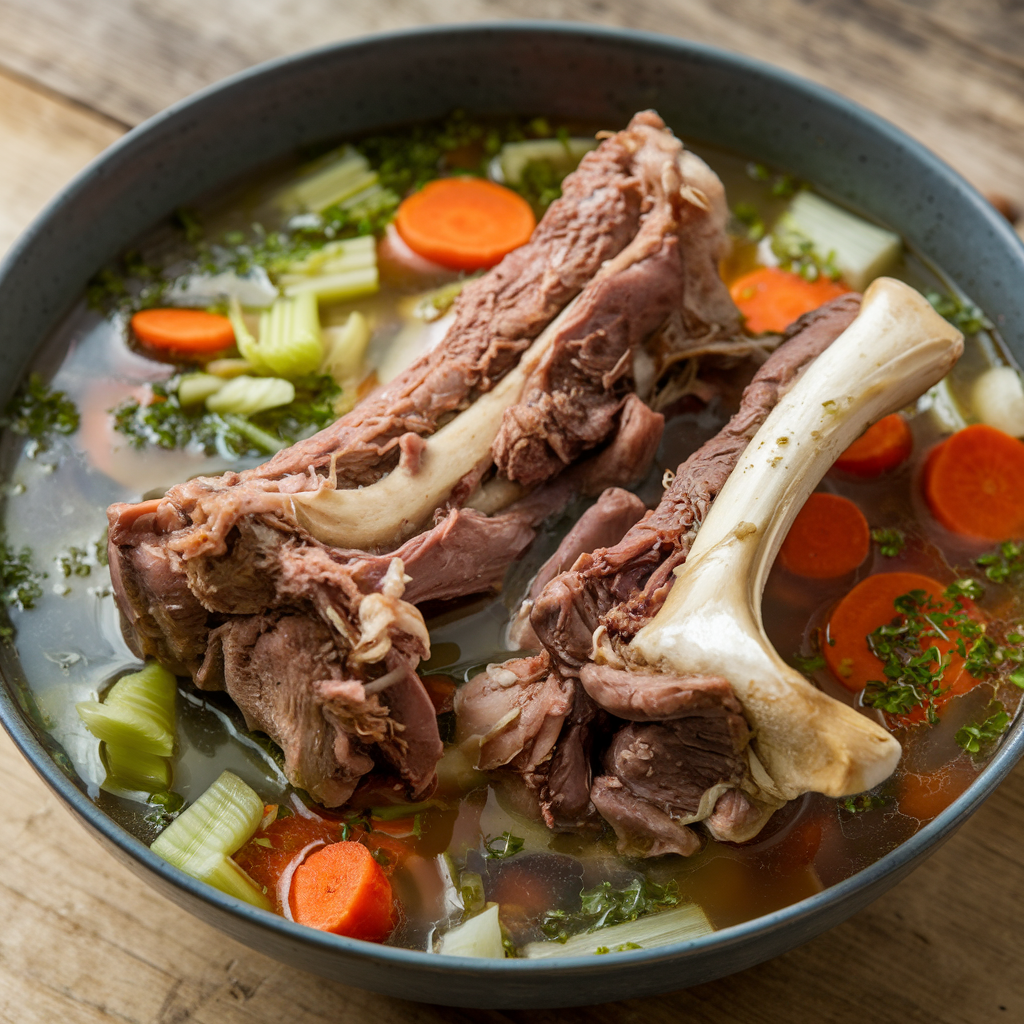
Beef bones produce a robust, savory broth, often used in stews, French onion soups, or as a base for sauces. Beef bone broth is also a popular choice for those seeking the health benefits of collagen, as it helps improve joint health and skin elasticity.
Chicken Soup Bones
particularly the carcass, wings, and feet, are perfect for making lighter, more delicate broths. Chicken broth is a staple in many kitchens, offering a versatile base for everything from soups to risottos.
- Carcass: After roasting or cooking a whole chicken, the carcass is a great base for broth. It provides a lighter flavor while still offering richness from the marrow and small bits of meat.
- Wings and Feet: Chicken wings and feet are rich in cartilage, which contributes to a gelatinous texture when cooked for a long time. The feet, in particular, are prized for their high collagen content, which makes for a more viscous and nutrient-dense broth.
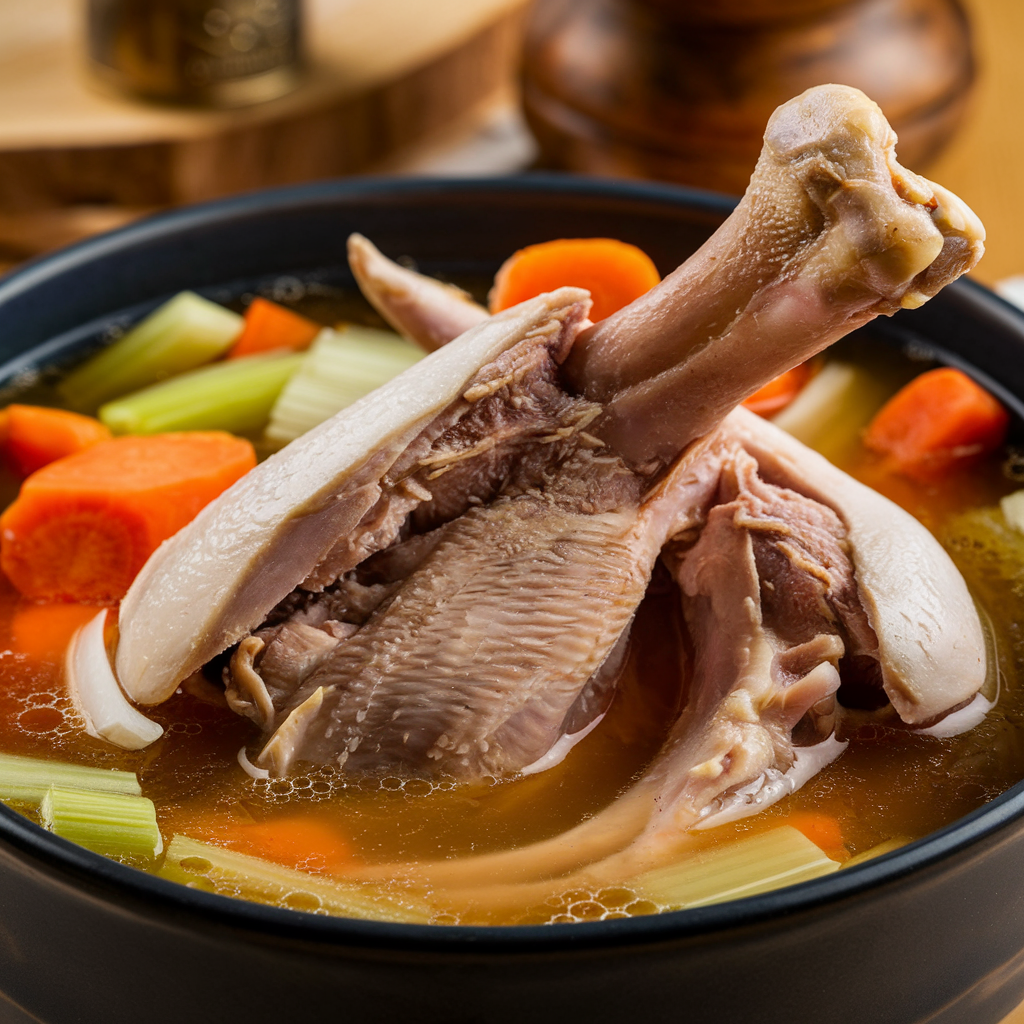
Chicken broth tends to be lighter in flavor than beef, making it perfect for lighter dishes such as chicken noodle soup, or for braising vegetables.
Pork Soup Bones
such as neck bones, hocks, and spare ribs, offer a distinctively rich and hearty broth. Pork broths are often used in Southern or Asian cuisines, providing a savory, flavorful base.
- Neck Bones: Pork neck bones are an affordable and delicious choice for making broth. They contain both meat and cartilage, which breaks down during cooking to create a flavorful, slightly gelatinous broth.
- Hocks: Pork hocks, which come from the lower leg of the pig, are another common choice. They are perfect for creating a rich, slightly smoky broth due to the fat and connective tissue present in the bones.
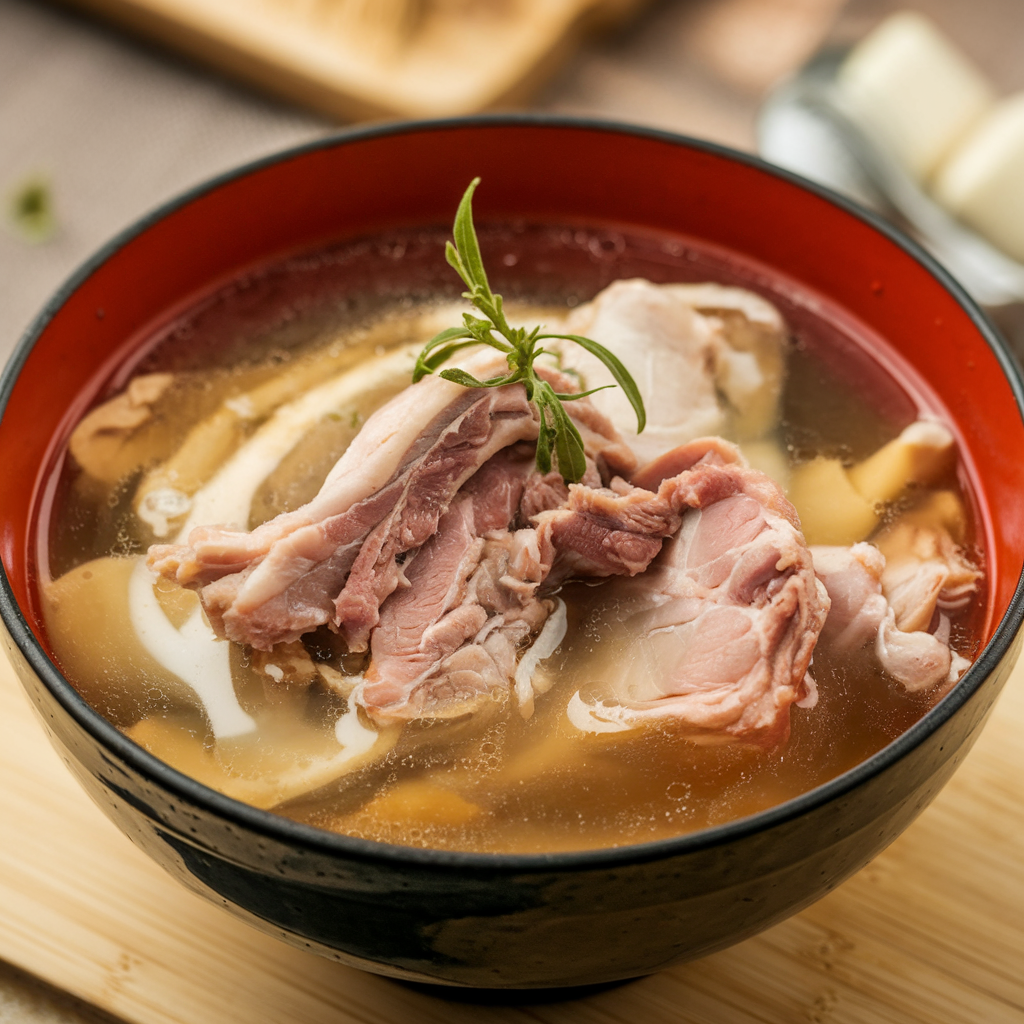
Pork bones create a broth that is robust and hearty, often used in dishes like split pea soup, collard greens, and ramen.
Lamb Soup Bones
Lamb soup bones are a great choice for those who enjoy a more unique, gamey flavor. These bones are ideal for making Mediterranean, Middle Eastern, or North African-inspired broths.
- Lamb Neck Bones: These are rich in both meat and fat, making them perfect for creating a hearty, flavorful broth. Lamb neck bones often yield a rich, gamey flavor that works well in slow-cooked dishes.
- Shank Bones: The shank is another cut that is often used for broths. It’s packed with marrow and connective tissue, resulting in a gelatin-rich broth.
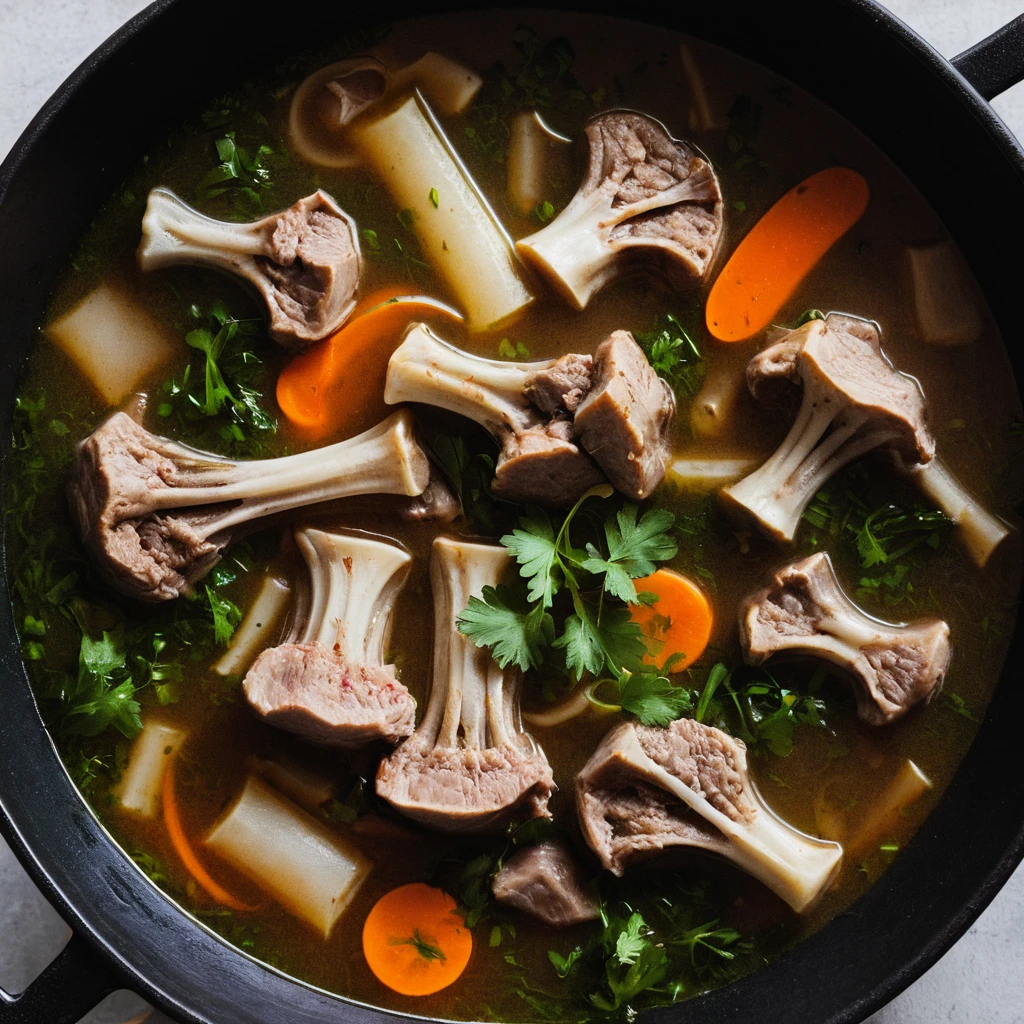
Lamb bones offer a unique taste and are perfect for soups such as lamb stew, Moroccan harira, or a Greek avgolemono soup.
Why Soup Bones Are Essential for Rich, Flavorful Broths
Soup bones are key to creating broths that are rich in flavor and texture. Here’s why they’re such an essential ingredient:
- Collagen and Gelatin: When simmered for an extended period, soup bones release collagen, which breaks down into gelatin. This process not only thickens the broth, giving it a silky, smooth texture, but also imparts a rich mouthfeel that makes the broth feel nourishing and satisfying.
- Long Cooking Time: The secret to a flavorful broth is time. Bones need to be simmered slowly for hours (or even overnight) to extract all the flavor and nutrients. As the bones cook, they release flavors from the marrow, cartilage, and connective tissue. This long cooking process ensures a deep, full-bodied broth.
- Nutritional Benefits: Bone broth is packed with beneficial nutrients such as calcium, magnesium, phosphorus, and collagen. These nutrients are essential for healthy bones, joints, and skin. The collagen, in particular, supports joint health and may improve the appearance of skin, reducing wrinkles and promoting elasticity.
How to Make the Perfect Broth with Soup Bones
Making a rich and flavorful broth from soup bones is an art that takes time and patience. However, with a few basic techniques, you can create a deep, nutrient-dense broth that enhances any recipe. Whether you’re using beef, chicken, pork, or lamb bones, the method remains largely the same: simmering bones over low heat to extract the full depth of their flavors and nutrients. Here’s a guide to making the perfect broth from soup bones.
Basic Soup Bone Broth Recipe
Making bone broth from soup bones is simple and rewarding, requiring just a few ingredients and patience to allow the flavors to develop fully. Here’s a basic recipe to follow:
Ingredients:
- 3-4 pounds of soup bones (beef, chicken, pork, or lamb)
- 1-2 large onions (quartered)
- 2-3 carrots (roughly chopped)
- 2-3 celery stalks (roughly chopped)
- 3-4 garlic cloves (smash them)
- 2 bay leaves
- 1 tablespoon black peppercorns
- Water (enough to cover the bones)
- 2 tablespoons apple cider vinegar
Instructions:
- Roast the Bones (optional): Roast the bones at 400°F for 30-45 minutes to deepen their flavor, especially for beef and pork.
- Prepare the Broth: Place the bones in a pot or slow cooker, add vegetables, garlic, and bay leaves, then cover with water. Add apple cider vinegar and let sit for 30 minutes to help extract nutrients.
- Simmer Slowly: Bring to a boil, skim foam, and reduce to low heat. Simmer chicken bones for 4-6 hours, or beef/pork bones for 8-12 hours. For a slow cooker, set to low for 12-24 hours.
- Strain the Broth: Once cooked, strain the broth to remove solids.
- Cool and Store: Let it cool, then store in the fridge for up to 5 days or freeze for long-term use.
This simple recipe yields a nutrient-rich, flavorful broth that can be used in soups, stews, or enjoyed on its own.
Tips for Enhancing Flavor
While the basic broth recipe will yield a delicious, savory result, there are several ways to enhance the flavor even further:
- Roasting the Bones: As mentioned earlier, roasting the bones before boiling them adds a deeper, caramelized flavor to the broth. This step is especially important for beef and pork bones.
- Adding Herbs: Fresh or dried herbs like thyme, rosemary, parsley, and sage can greatly enhance the flavor of the broth. Tie them in a bundle or add them directly to the pot during the last hour of cooking.
- Vegetables: Vegetables like leeks, tomatoes, and parsnips can add complexity and sweetness to the broth. Roasting them along with the bones will bring out even more flavor.
- Spices: For a more exotic twist, try adding spices such as ginger, cinnamon, or star anise (great for lamb or pork broth). A splash of soy sauce or a dash of miso can also bring umami and deepen the flavor profile.
Cooking Time and Techniques
The cooking time and method you choose will affect the final texture and flavor of your broth.
- Simmering: This is the traditional method, where you cook the bones gently over low heat for hours. This process allows the collagen and minerals to break down slowly, creating a thick, gelatinous broth. Beef and pork bones, especially those with a lot of connective tissue, need a longer simmer (8-12 hours) than chicken bones (4-6 hours).
- Pressure Cooking: If you’re short on time, a pressure cooker or Instant Pot can dramatically reduce the cooking time while still extracting plenty of flavor from the bones. You can cook beef or pork bones in about 1.5-2 hours under high pressure, and chicken bones in about 45 minutes. The pressure cooker breaks down the collagen quickly, providing a similar result to long simmering.
- Slow Cooker: Using a slow cooker is one of the easiest ways to make broth. It’s hands-off and ensures the bones cook slowly for a long period without requiring constant attention. Simply set it on low for 12-24 hours and let the cooker do the work.
- Stovetop vs. Oven: If you’re using a stovetop to simmer, make sure the heat is kept low. The slow, steady cooking process is key to getting the most flavor from the bones. Alternatively, if you’re roasting bones before simmering, you can use the oven to roast them at around 400°F for 30-45 minutes, which adds a deeper flavor to the broth.
Recipes Using Soup Bones
Soup bones are not just for broth; they can be used in a variety of delicious dishes, from soups to stews to sauces. Here are some recipe ideas to get the most out of your soup bones.
Classic Beef Bone Broth
A classic beef bone broth is a staple in many kitchens, offering a rich, savory base for soups, sauces, and gravies.
Ingredients:
- 3-4 pounds of beef bones (knuckle, marrow, or oxtail)
- 2 large onions (quartered)
- 3 carrots (peeled and chopped)
- 3 celery stalks (chopped)
- 2 garlic cloves
- 1 tablespoon of apple cider vinegar
- 10 cups of water
- 2 bay leaves
- Salt and pepper to taste
Instructions:
- Roast the bones in the oven at 400°F for 30-45 minutes.
- Transfer the bones to a pot or slow cooker. Add vegetables, garlic, vinegar, and water.
- Bring to a boil, then reduce heat to low and simmer for 8-12 hours, skimming off any impurities.
- Strain the broth and season with salt and pepper to taste.
Chicken Bone Broth Soup
This light and flavorful chicken broth soup can be made by using the carcass, wings, and feet of a chicken.
Ingredients:
- 1 whole chicken carcass (plus wings or feet if available)
- 1 onion (quartered)
- 2 carrots (peeled and chopped)
- 2 celery stalks (chopped)
- 4 garlic cloves (smash with knife)
- 1 tablespoon apple cider vinegar
- 8 cups of water
- Salt and pepper to taste
Instructions:
- Place chicken carcass in a large pot and cover with water. Add vinegar and let sit for 30 minutes.
- Bring to a boil, then reduce to a simmer. Add vegetables and simmer for 6 hours.
- Strain the broth and use the remaining chicken for other dishes or add back to the soup
How to Choose the Best Soup Bones
When making bone broth or cooking with soup bones, the quality of the bones is crucial to the final flavor and nutritional benefits. Not all bones are created equal, and the choice of bones can impact the taste, texture, and health properties of your broth. In this section, we’ll cover how to select the best soup bones to get the most out of your cooking.
Where to Buy Soup Bones
Finding high-quality soup bones can be easy if you know where to look. Here are some options for sourcing the best bones for your broth:
- Butcher Shops: Local butcher shops are a great place to find fresh soup bones. They often have a variety of bones available, including marrow bones, knuckle bones, and oxtails, and may offer cuts of meat with the bones still attached.
- Farmers’ Markets: Many farmers’ markets feature vendors who sell pasture-raised meats and bones. This is an excellent way to find high-quality, ethically sourced soup bones.
- Online Suppliers: There are numerous online companies that specialize in selling high-quality bones for broth. Many of these suppliers offer bones from grass-fed, pasture-raised, or organic sources, delivering straight to your door.
- Grocery Stores: Some grocery stores, especially those with a butcher section, sell soup bones. Look for cuts like beef neck bones, chicken carcasses, or pork hocks. Be sure to choose bones that are fresh and not prepackaged with excess preservatives.
How to Prepare and Cook Soup Bones
Preparing soup bones properly is essential to maximize the flavor, nutrients, and texture of your broth. While the process is relatively simple, following a few key steps can make a significant difference in the final product. In this section, we will guide you through the process of preparing and cooking soup bones for the best results.
Preparing Soup Bones for Cooking
Before you start cooking your soup bones, it’s important to prepare them properly to extract the maximum flavor and nutrients.
Blanching Bones to Remove Impurities
One common technique when making bone broth is to blanch the bones before simmering them. Blanching helps remove any impurities, blood, or other unwanted substances that can cloud your broth or affect its taste.
- Step-by-Step Blanching Process:
- Rinse the Bones: Start by rinsing the soup bones under cold water to remove any visible dirt or debris.
- Boil the Bones: Place the bones in a large pot and cover them with cold water. Bring the water to a rapid boil, then reduce the heat to a simmer. Let the bones simmer for 5-10 minutes.
- Skim the Foam: As the bones begin to boil, a foam-like substance will form on the surface. Skim this off using a spoon or ladle. This helps remove impurities and results in a clearer broth.
- Drain and Rinse: After blanching, drain the bones and rinse them with cold water to remove any remaining impurities.
Blanching isn’t necessary for all recipes, but it can improve the clarity and taste of your broth, especially when using bones that may have been frozen or stored for a while.
Roasting Bones for Added Flavor
Is another technique that can enhance the depth and richness of your broth. Roasting caramelizes the natural sugars in the bones, adding a deep, savory flavor to the final product.
- How to Roast Soup Bones:
- Preheat the Oven: Preheat your oven to 400°F (200°C).
- Arrange the Bones: Place the bones in a single layer on a baking sheet. You can also add vegetables like onions, carrots, and celery to the pan for additional flavor.
- Roast the Bones: Roast the bones for 30-45 minutes, or until they are browned and caramelized. Be sure to check periodically to avoid burning the bones.
- Deglaze the Pan: Once roasted, transfer the bones to your cooking pot and add a bit of water to the roasting pan to deglaze it. Scrape up any browned bits (fond) from the bottom of the pan and add them to the broth for extra flavor.
Is particularly useful for beef, pork, or lamb bones, where a richer, more robust flavor is desired. For chicken or fish, it’s generally not necessary, as these bones are more delicate and don’t require the same level of caramelization.
Cooking Soup Bones to Make Broth
Once the bones are properly prepared, it’s time to cook them. The key to a great broth is a slow, long simmer, which allows the collagen and nutrients to be released from the bones and into the liquid.
Tips for Enhancing the Flavor of Soup Bones
While the bones themselves provide the base of the broth, additional ingredients can take your soup to the next level, adding layers of flavor and complexity.
- Herbs and Spices: Adding herbs like thyme, rosemary, bay leaves, and parsley can enhance the flavor of your broth. Garlic, peppercorns, and a small piece of ginger can also bring depth to the broth.
- Vegetables: Carrots, onions, and celery are classic additions to bone broth. These vegetables add sweetness and earthiness to balance the richness of the bones. You can roast them along with the bones for even more flavor.
- Acid: A small amount of apple cider vinegar or lemon juice helps extract minerals from the bones and adds a slight tang to the broth, enhancing its overall flavor.
- Salt: Add salt at the end of cooking to taste. Salt too early can make the broth too salty, as it concentrates over time.
Experimenting with different herbs, spices, and vegetables can help you create a bone broth tailored to your tastes.
Nutritional Benefits of Soup Bones
Soup bones are more than just a flavorful ingredient for making broth. They are also packed with a range of nutrients that can have significant health benefits. From collagen to essential minerals, the broth made from soup bones can contribute to improved joint health, skin elasticity, and overall well-being.
In this section, we will explore the various nutrients found in soup bones and their associated health benefits.
FAQ
Q: What are soup bones?
A: Soup bones are the bones of animals, typically beef, pork, or chicken, that are used to create rich, flavorful broths and soups. These bones contain marrow, collagen, and connective tissue, which break down during slow cooking, adding depth, nutrition, and a velvety texture to soups and stews.
Q: How are soup bones used in cooking?
A: Soup bones are typically simmered in water for several hours to extract the flavor, nutrients, and gelatin from the bones. This slow-cooking process results in a rich, hearty broth that serves as the base for various soups, stews, or sauces. You can also add vegetables, herbs, and seasonings to enhance the flavor of the broth.
Q: Can you eat soup bones?
A: While you can eat the meat that remains on soup bones after they have been simmered, the bones themselves are not typically eaten. The marrow inside the bones is edible, and it can be scooped out and added to the soup for extra richness and flavor. The bones, however, are generally discarded after the broth is made.
Q: What are the benefits of using soup bones?
A: Soup bones are a great source of collagen, which can help improve joint health, skin elasticity, and gut health. The long cooking process also releases minerals like calcium and magnesium, making the broth a nutritious addition to your diet. Additionally, soup bones are a budget-friendly way to make a flavorful, nutrient-packed broth from basic ingredients.
Q: Where can I buy soup bones?
A: Soup bones can be found at most grocery stores, butcher shops, or farmer’s markets. They are often sold at a low price, as they are considered a byproduct of meat processing. You can also find pre-packaged soup bones in the frozen section at some supermarkets.
Conclusion
Soup bones offer more than just great flavor. They are a powerful source of nutrients like collagen, amino acids, and essential minerals, all of which support overall health, including joint function, skin elasticity, and gut health. By making your own bone broth at home, you can take advantage of these benefits in a cost-effective and delicious way.
Whether you enjoy bone broth on its own or use it as the base for other dishes, it’s a versatile and highly nutritious ingredient that can play a significant role in a healthy diet. So, don’t let those bones go to waste—make the most of their nutritional potential and enjoy all the benefits that homemade bone broth has to offer.

